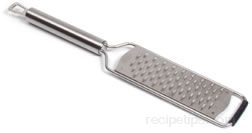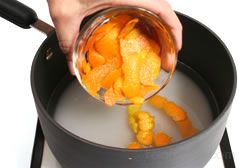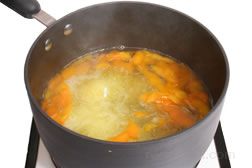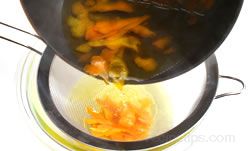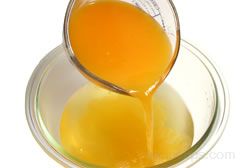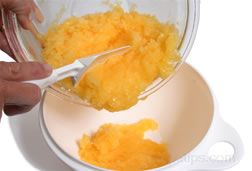|
Orange Preparation | Freezing Oranges | Orange Recipes | Tips
| Oranges |
|
A baseball-sized citrus fruit that generally has an orange skin and flesh that is a segmented ball of pulp and juice wrapped in a thin semi-transparent membrane. Its flesh is juicy and may have a sweet to slightly bitter taste, depending on the variety. The flesh is enclosed in a skin that is made up of two layers. The aromatic outer layer is the zest, which has a shiny appearance and is generally orange in color but can also be green, yellow or orange with patches of red. The layer under the zest is the pith, which is a light creamy color and has a soft texture with a bitter taste. They are grown in regions with a subtropical or Mediterranean climate. There are three main types of oranges: the sweet oranges; the loose-skinned mandarins; and the bitter oranges. Oranges are a good source of vitamins, such as vitamin C and four B vitamins, high in dietary fiber, and are also a good source of many important minerals. |
|
Uses:
Most oranges make a great snack that can be eaten out-of-hand. The flesh is generally sweet and juicy. The juice from oranges is very popular worldwide. Oranges are also used in making salads, desserts, ice creams, sorbets, and some savory dishes. They are also used as a garnish. The juice, flesh and zest can all be used.
The loose-skinned mandarins can also be eaten out-of-hand and peel much easier than oranges. They are used in salads and desserts and can generally be substituted for oranges in most recipes. As with oranges, the juice, flesh and zest of the mandarins can be used.
The flesh and juice from the bitter orange are sour and are not eaten raw. They are used to make jams, jellies and marmalades. The oil from their skin is very aromatic is used to flavor liqueurs. |
| At Their Best:
Sweet oranges have varieties that are available at different times throughout the year so generally there are sweet oranges available all year round. Navels are available November to May, peaking in January, February and March. Valencia oranges are available February to October, peaking in May, June and July.
Mandarin oranges have varieties that are available from November through April. Canned mandarin oranges are available throughout the year.
Bitter oranges are not readily available throughout the year. They are generally available late winter and early spring. |
|
How to Buy:
Select fruit that is firm and heavy for its size, which indicates that it contains more juice. Avoid any fruit that has damaged, shriveled, or moldy spots on the skin. The skin should be fairly smooth and it may have slight greening or a rough brown patch, which will not affect the quality of the orange. The rough brown spot is called "russeting" and the greening is caused by reabsorbtion of chlorophyll after the fruit has ripened on the tree and is then exposed to warm temperatures.
The mandarins will feel soft and puffy compared to other oranges because of their loose skin. Their deep orange skin will be slightly glossy and should not be damaged, shriveled, or have moldy spots. Select fruit that is heavy for its size.
If purchasing a bag of fruit, be sure to check the fruit carefully. Check for mold or damaged spots. If there is mold on any of the oranges, it will cause the rest of the fruit to deteriorate more quickly. |
|
Storage:
Oranges can be stored at room temperature for up to 7 days. When stored at room temperature, they will be juicier than if stored in the refrigerator. To keep oranges for a longer period of time, store them unwrapped in the refrigerator. If they are stored in a plastic bag, leave the bag open or be sure it has some holes perforated in it to allow air circulation. Proper air circulation is necessary to avoid moisture being trapped in the bag. Moisture promotes mold growth. If stored in the refrigerator, the oranges will stay fresh for up to two weeks.
Tangerines and other mandarins do not store as well as oranges. They can be refrigerated for 5 to 7 days.
Orange juice and zest can be frozen and then stored for up to a year in the freezer. The juice will retain its vitamin C for up to a year if frozen properly. |
| Sweet Orange Varieties: |
|
Blood Orange

|
An orange that is slightly smaller than the other sweet oranges. It has orange-red skin and flesh that is orange with red streaks or a deep red color. It is sweeter than other varieties of oranges, providing a stronger citrus flavor, is less acidic, and generally seedless. They can be used like any other orange but are best used when color is important. Blood oranges are available in well-stocked supermarkets. They are also used to produce blood orange olive oil, which has been on the market for only a few years. It is a blend of extra virgin olive oil and crushed blood oranges, which is used as a salad dressing, a condiment for fish and meat dishes, and to add flavor to numerous recipes. Blood oranges are also known as Pigmented oranges, Moro oranges, Sanguina, Sanguine, or Sanguinella. |
|
Navel Orange
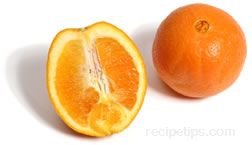
Navel Orange

Red Navel Orange
|
A juicy fleshed orange having a thicker skin, which is generally easy to peel, with flesh that is juicy and sweet. The Naval orange makes a good fruit for juice or for snacking and fruit salads. There are two common varieties of this orange, the Naval and the Red Naval. The Naval has an orange colored flesh while the Red Naval has a ruby flesh that is due to the presence of lycopene, as occurs with the ruby flesh of the red grapefruit. Navel oranges are easy to recognize because of the growth that resembles a human navel on the end opposite the stem end. This growth contains a small embryonic fruit in the orange. The navel orange is also referred to as the Bahia, Riverside or Washington navel. |
|
Valencia Orange
 |
A deep colored, small to medium sized orange that has a thin skin, which is hard to peel, but once peeled it reveals a flesh that is juicy and sweet. The Valencia orange contains a great amount of juice and because of its thin skin it is easy to squeeze. It is also a good eating orange and contains a few or no seeds. It is grown in Florida, California, Arizona and Texas and is in season for most of the year. |
| Bitter Orange Varieties: |
|
Bergamot
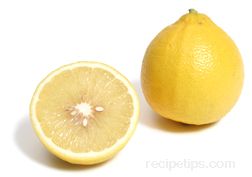 |
A small, slightly pear-shaped, bitter and acidic fruit, which has a high content of juice and contains a lot of seeds. Bergamot oranges have a fairly smooth, thin skin that ranges in color from green to yellow, depending on its ripeness. It is mostly used for its essential oils, which provide a strong scent for perfumes and cosmetics, and flavoring for liqueurs. The peel is dried and used as flavoring in teas, such as Earl Grey tea. Its scent is used in aromatherapy and is said to help with depression. Bergamots are mostly produced in Italy. |
|
Seville
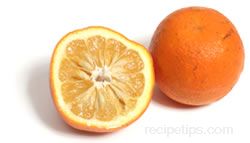
|
A bitter tasting orange with a flattened appearance and rough, thick skin. The flesh contains a lot of seeds. Seville oranges are generally not eaten out-of-hand because of their acidic taste but are more often used for cooking because of their strong orange flavor. They are popular for making marmalades, jellies, and jams, flavoring liqueurs, and are used in marinades. They are mostly grown in the Mediterranean regions and have a short growing season so they are not always readily available. Also referred to as Bigarade oranges. |
| Loose-Skinned Varieties: |
| Mandarins: |
 |
| Honey |
A variety of mandarin orange that has a rich sweet flavor with thin skin that has a smooth shiny texture. It has a slightly flattened shape with no neck. The Honey Mandarin is very fragrant and easy to peel and segment. Its flesh is very juicy and contains many seeds. Honey Mandarins are available from middle of January through April. |
|
Ortanique
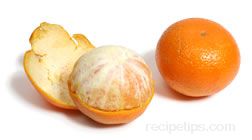
|
A variety of mandarin orange that is a cross between a tangerine and a sweet orange. They have a very sweet flavor and are very juicy. Their bumpy skin is tight fitting in comparison to other mandarins, making them more difficult to peel. The ortanique has a round, slightly flattened shape. Ortaniques are hard to find due to the fact that they are mostly produced in Jamaica. Producers have tried to grow them in Florida and California with little luck in producing the same sweet flavor as the fruit grown in Jamaica. Ortaniques are available from February through April. |
|
Satsuma
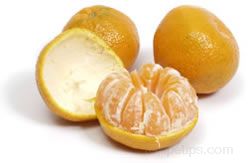
|
A mandarin variety that is light orange in color and has the shape of a flattened orange. It has a slightly rough textured skin that is loose and easy to peel. The flesh is easily segmented and contains little or no seeds. The orange flesh has a mildly sweet flavor. Satsuma mandarins are available from middle October through December. They are the first mandarins of the season ready for harvest. |
|
Tangor (Royal Mandarin or Temple Orange)
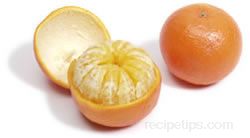
|
A variety of mandarin orange that is a cross between a tangerine and an orange. It is one of the larger mandarins and is more rounded in shape. The tangor is reddish-orange in color with a slightly rough skin that is easy to peel. Its flesh is juicy and has a sweet flavor with a slight spiciness to it. The tangor contains few seeds. It is available January through March. Tangors are referred to as Royal Mandarins or Temple Oranges. |
|
Tangelo

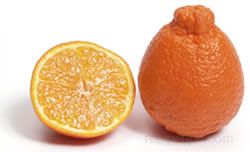
Minneola Tangelo

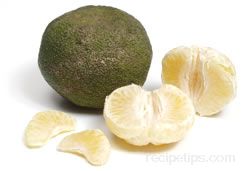
Ugli Fruit
|
A variety of mandarin orange, which is a hybrid fruit that is a cross between a grapefruit and a tangerine or a pummelo and a tangerine. Larger in size than tangerines, a tangelo is oval in shape and generally has a bright reddish-orange outer skin and inner flesh. The shape, flavor and seed content vary with the different varieties of tangelos.
Minneola Tangelo has a slightly elongated shape with a protruding neck at the stem end of the fruit. Its orange flesh is juicy, sweet with a mild tartness and contains little or no seeds. Its skin is a dark reddish-orange that has a smooth to slightly pebbly texture and is fairly easy to peel. The Minneola Tangelo is the most common tangelo and is generally only available in January. It is also referred to as Mineola Tangelo or Honeybell Tangelo.
Orlando Tangelo has a round, slightly flattened shape. It does not have the protruding neck of the Minneola Tangelo. Its deep orange skin is slightly textured and tighter fitting than the Minneola, making it harder to peel. The Orlando's flesh is mildly sweet and juicy, containing few seeds. It matures early, making them available from the middle of November up until the first part of February.
Ugli Fruit is a variety of tangelo that got its name because of its unattractive appearance. It is uncertain whether it is a cross between a tangerine and grapefruit or the pummelo, or if it has been crossed with a bitter orange. Its appearance does not have an affect on its juicy, seedless flesh. Its flesh is pink or orange in color and mildly acidic. Ugli fruit's flavor is resemblance of both grapefruit and mandarin oranges but is sweeter than grapefruit. It has a thick, bumpy, wrinkled skin that is easy to peel and depending on the variety, it is orangish-yellow, yellowish-red, or green in color. Ugli fruit is generally larger than other tangelos. They can be eaten out-of-hand or the juice can be used in cooking. They are available from December to April. Also referred to as "uniq fruit." |
|
Tangerines
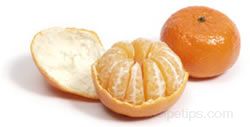
Clementine Tangerine
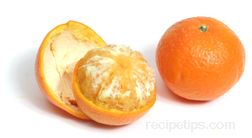
Fairchild Tangerine
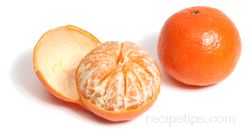 Fallglo Tangerine Fallglo Tangerine

Honey Tangerine
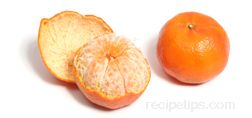
Sunburst Tangerine
|
Tangerines and mandarins are sometimes mistakenly referred to as the same fruit but tangerines are actually a subgroup of the mandarins. The tangerine is a cross between mandarins and the bitter orange. There are many different varieties of tangerines. Their skins are generally deep reddish-orange, slightly textured, loose fitting, and easy to peel. They contain 8 to 15 segments, which are easily separated. Most tangerines are smaller in size than an orange and have a slightly flattened shape. Their size, shape, color, and flavor varies with the different varieties.
Clementine Tangerine is the smallest variety of tangerine. Its skin is deep orange in color and has a smooth to slightly rough texture. The membranes for the segments are thinner than other tangerines, making the flesh more delicate. The flesh of the Clementine is juicy and very sweet flavored, and it contains little or no seeds. The majority of the Clementines are imported here from North Africa and Spain but some are grown in California and Florida. They are available in the middle of November up until the beginning of February. They are also referred to as the Algerian tangerine.
Dancy Tangerine is a common variety of tangerine that has a thin rind, which is deep reddish-orange in color, smooth and easily peeled. It is small in size in comparison to some of the other varieties. Its flesh is dark orange with a rich, sweet flavor that has a hint of spiciness to it. The Dancy contains a fair amount of seeds and does not hold well after maturity. Available in the middle of December until the beginning of February.
Fairchild Tangerine is the variety first to ripen during the season in North America. It is a popular variety in the United States. The Fairchild has a slightly flattened shape with a lightly pebbled, deep orange rind. It has a thin skin but is still fairly easy to peel. The flesh contains seeds but is juicy with a rich sweet flavor. Fairchild tangerines are sometimes found with the stem and leaves still attached. The Chinese believe the stems and leaves attached to the tangerine are a symbol of prosperity and good luck. It is available from October to Middle of January.
Fallglo Tangerine is one of the larger varieties of tangerines. Its thin rind is deep orange in color and easy to peel. The juicy flesh is also deep orange in color and has a sweet flavor. It is available from the middle of October through November.
Honey Tangerine is a variety of tangerine that is high in sugar content, giving it a rich sweet flavor. They are small to medium in size and their rind, which is fairly smooth textured, is yellowish-orange in color with a tinge of green at times. Its flesh is a dark orange color and contains some seeds. It is available January through April. Honey tangerines are also referred to as Murcott oranges.
Sunburst Tangerine is a variety of tangerine that has a very smooth, thin rind. The rind is so thin that you can see ridges from the segmented section of the flesh. Its rind is a dark reddish-orange color and is easy to peel. The flesh is deep orange colored and has a rich, sweet flavor. The Sunburst has little or no seeds. It is available from November through the middle of January. |
Orange Preparation
Preparation Tools | Peeling Oranges | Segmenting and Cutting Sections | Zesting | Juicing | Slices, Wedges and Garnishes | Mandarin Preparation
Lemons have many uses but preparing them for use is fairly basic. It will generally involve, zesting, juicing, slicing or peeling. Some of the preparation tools and basic preparation methods are described below. Before preparing the lemons in any manner, they should be washed thoroughly to remove any dirt, bacteria, or pesticide residue that may remain on the surface.
Preparation Tools
Zesting Tools
 |
Paring Knife - The tip of the paring knife is used to cut thin strips of zest from the outer peel of the orange. |
 |
Vegetable Peeler - A vegetable peeler can be used to cut wide strips of zest from the outer peel. Strips can be cut vertically from one end to the other or by cutting strips around the orange, starting at one end and working around and down towards the opposite end. |
 |
Citrus Peeler - A tool used to cut the rind on citrus fruit for the purpose of making it easier to peel. The cutting end cuts through the peel and the curved end separates the rind from the fruit, making it easier to peel the rind away from the fruit. |
|
The strips removed by the vegetable peeler or knife can be used as wide strips or cut into thinner strips, depending on the intended use. |
Grater - A metal grater can be used to produce fine particles of zest. The surface of the orange is rubbed diagonally across the grater and the orange turned often to avoid grating the layer of white pith. |
 |
Citrus Zester - A zester tool can be used to remove fine strips of zest from the surface of the orange. The tool is pulled across the skin to remove the fine strips, which can then be used as strips or minced to produce a finer zest. |
Juicing Tools
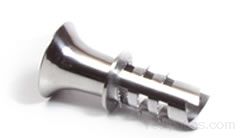 |
Citrus Trumpet - A tool used to extract the desired amount of juice from citrus fruits. This tool is screwed into the fruit and the outer rind is squeezed until the desired amount of juice flows out the spout of the extractor. This type of tool is also known as a juice extractor. |
|
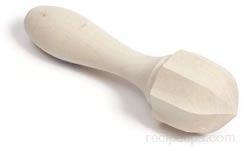
|
Reamer - A hand tool that is typically used to extract juice from citrus fruits, such as oranges, lemons and limes. This kitchen utensil has a fluted cone-shaped reaming end that is twisted into and against the meat of the fruit to release the juice. It is available in hard plastic, wood, or metal. The hand reamer is primarily made to extract smaller volumes of juice from fruits during food preparation. |
|

|
Hand Juicer - Hand juicers are generally built with a solid ribbed cone that is attached to a shallow bowl type base or it may be a separate piece that attaches to a base that is used for collecting the juice. The orange half is pressed down onto the cone and turned manually. As it revolves around the cone, the pulp is crushed and the liquid flows into the bowl or holding platter below. |
|
Citrus Press - This hand press is similar to a hand juicer in that it works with a cone to remove the juice. The fruit is place on the cone and then a press is forced done on the fruit, forcing the juice out with pressure rather than by a twisting motion.
Electric Juicers - This machine works with a motor that turns the reamer as it extracts the juice. The half section of fruit is pressed down on the reamer and the motor starts the reamer rotating and continues rotating until the fruit is released. The juice flows into a pitcher or other holding container that is part of the juicer. |
Peeling Oranges
|
Peeling Oranges - Without Removing the Membranes from the Flesh.
To make it easier to peel and remove the pith from the oranges, place the oranges in boiling water, remove from heat, and allow to stand for 4 to 5 minutes. |
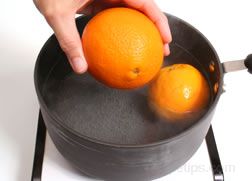 |
| Remove the oranges from the water and allow to cool for a few minutes or until they are not too hot to handle. |
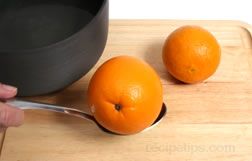 |
|
When cool enough to handle, use a sharp knife or a citrus peeler to score the peel around the stem end, being careful not to cut into the flesh. Then remove the stem end of the peel. |
 |
| After removing the stem end, carefully score the peel from the stem end down to the opposite end without cutting into the flesh. Make four even cuts in this manner around the orange, dividing it into four even sections. |
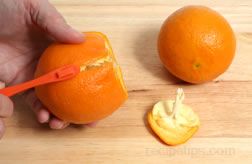 |
|
Using your fingers, peel each section away from the flesh. The peel and pith should come off easily. |

|
| Any pith that remains can be carefully removed by scraping with a paring knife. |
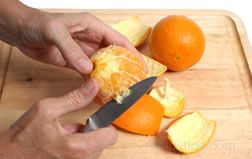 |
|
Peeling Oranges - Without Placing in Boiling Water First.
If you are going to peel an orange and do not have access to boiling water, the orange can still be peeled. They can be peeled in basically the same manner, just eliminate placing in boiling water first. Eliminating this step will cause more of the pith to remain on the orange when it is peeled. |
 |
| Use a small knife to scrape off as much of the pith as possible after the peel is removed from the orange. |
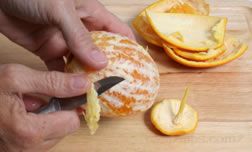 |
|
Peeling Oranges - Removing the Membranes from the Flesh.
To remove the membrane along with the outer skin and pith, first cut a slice off the top and bottom of the orange. |
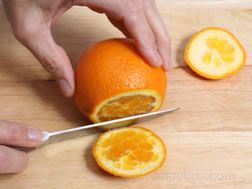 |
| Place one of the cut sides down on a cutting surface and begin to cut the skin and pith away from the flesh of the orange starting at the top and working towards the bottom. Follow the natural curve of the orange as you are cutting and be sure to cut away the outer membrane of the flesh with the skin and pith. |
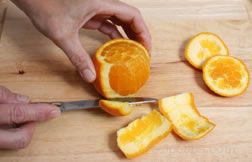 |
|
Continue to cut the skin, pith and membrane from the remainder of the orange.
The orange can then be cut into slices or sections as shown below. |
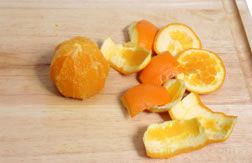 |
Segmenting and Cutting Sections
|
Separating Segments
Peel the orange leaving the membrane around the flesh using the method shown above.
Once the orange has been peeled it can be separated into individual segments. Begin by gently pulling the orange apart to form two halves. |
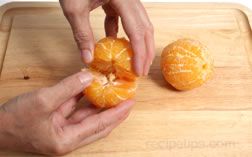 |
| Separate the individual segments by carefully pulling the the individual pieces from each half. |
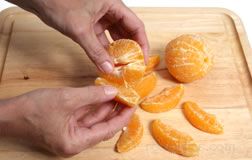 |
| Bite Size Pieces - The orange segments can also be cut into bite size pieces. First pull the peeled orange in half lengthwise and cut a wedge out of the center to remove the core or get a hold of the core with your fingers and peel it out of the center of the orange half. |
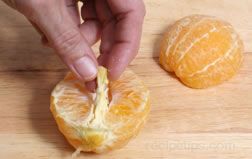 |
| Place the orange half with the inside down and separate the individual segments by carefully pulling them apart but leaving them slightly attached at one end. |
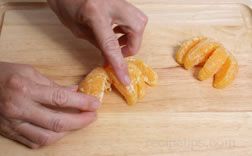 |
| Cut the orange segments crosswise to create bite size pieces. |
 |
|
Cutting Sections
Peel the orange by cutting away the skin, pith and membrane around the flesh using the method shown above.
Once the outer skin, pith and membrane have been removed, hold the orange in one hand and begin cutting close to the membrane that separates each segment. Cut on both sides of the membrane to free the section from the orange. |
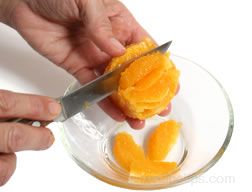 |
| The sections should not contain any pith or membrane once they are cut free of the orange. These sections are called "supremes." Be sure to work over a bowl when cutting the sections free so that the juices are collected. |
 |
| Place the supremes in the bowl with the juice until ready to use to keep them fresh. After all sections have been removed from the orange, squeeze the remaining orange over the bowl to collect any remaining juices. |
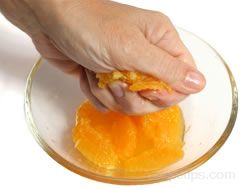 |
Zesting Oranges
Orange zest is the orange colored outer peel of the orange, which provides an aromatic citrus flavor that can be used to enhance the flavor of many sweet and savory foods and beverages. Orange zest can be substituted in many recipes calling for lemon zest to give the recipe a little different flavor. The white part of the peel beneath the zest is the pith, which has a bitter taste. When removing the zest from an orange, care should be taken to not remove the white pith along with it. The zest can be removed as thick or thin strips, very thin strands or grated pieces. Shown below are some common methods used for creating zest.
|
Wash oranges thoroughly before beginning preparation.
Zesting with a Knife
Orange zest strips can be made by cutting vertical strips off the orange with the tip of a small knife. Be careful not to cut into the bitter pith layer. |
 |
|
Zesting with a Vegetable Peeler
The zest could also be removed in the same manner that you would peel the skin from an apple with the vegetable peeler. Start peeling at the stem end of the orange and cut around the orange, working down towards the blossom end.
Orange zest strips can also be made by using a vegetable peeler to cut vertical strips from the orange. |
 |
| Be careful not to cut into the bitter pith layer when cutting strips of zest from the orange. If you do get some of the pith layer, use the tip of the knife to cut or scrape the pith from the zest strip. |
 |
|
Julienne Strips of Zest
The wide strips of orange zest can then be used as is or they can be trimmed to thinner strips, depending on the intended use.
To julienne, cut the strips lengthwise into the desired thickness. |
 |
|
Zesting with a Grater
To grate the orange zest, rub the orange diagonally against a metal grater, making sure to turn the fruit so that you are taking off the orange part of the peel and not the white pith. |

|
| Grating the orange peel will produce fine pieces of zest. Grate zest over a piece of wax paper to make clean up easier when you are finished. |
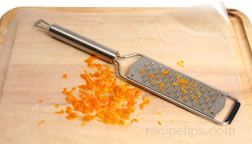 |
|
Zesting with a Citrus Zester
A citrus zester can also be used to remove the zest from the orange. The zester removes the zest in fine threads, which can be used just as they are or they can be minced and used as an alternative to grated zest. |
 |
| Note: The zest can be frozen and used later, so if you are just juicing the oranges, you can remove the zest before cutting up the oranges. It is easier to remove the zest from a whole orange than one that has already been juiced. Place the zest into an airtight freezer bag or container and freeze for up to 6 months. |
Juicing Oranges
Orange juice can be used as a beverage straight from the orange without adding any other ingredients. It is also used to enhance the flavor of many sweet and savory dishes. Because of it high content of vitamin C (ascorbic acid), orange juice can also be brushed on fruits and vegetables that brown easily when exposed to air or it is added to water and the fruit is soaked in the acidulated water for a short period of time to prevent it from browning. Shown below is a common method of removing the juice from the oranges.
| The oranges should be room temperature or warmer before the juice is removed. This will make it easier to squeeze the fruit and produce more juice. |
| If oranges are not at least room temperature, warm them by placing in the microwave. First poke the skin with a fork, being careful not to poke all the way through the skin to the flesh.
Place the orange(s) in the microwave on high for 20 to 30 seconds. |
 |
|
Oranges can also be warmed by placing them in a bowl and pouring boiling water over them. Allow them to sit in the hot water for 30 seconds.
Another method for warming the oranges is to place them in an oven preheated to 300°F for 3 minutes and then allow them to cool before handling. |
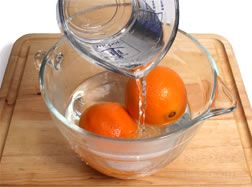 |
| After the oranges have been warmed, allow them to cool until they are easily handled and then roll them on a solid surface using the palm of your hand. Roll until you feel the flesh softening. |
 |
|
After rolling the oranges, cut them in half crosswise. Place one half of the orange on the juicer, apply pressure and twist the fruit to remove the juice. The juice can also be removed by squeezing the orange by hand. |
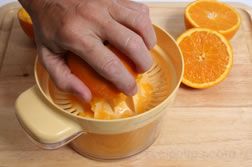 |
|
Remove all the seeds from the juicer once you have finished.
If desired, some of the extra pulp that has collected in the bottom of the juicer can be added to the orange juice once the seeds have been removed. If it is necessary to use pulp-free juice, strain juice to separate any pulp that may have gotten into the juice. |
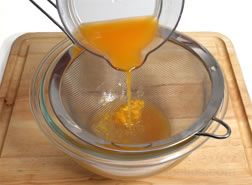 |
Slices, Wedges and Garnishes
|
Slices
Wash oranges thoroughly before cutting.
To create orange slices, cut the orange in half crosswise and then cut slices crosswise from each half. Cut the slices 1/8 to 1/4 inch thick. |
 |
| If desired, the orange slices can be cut in half again to form half moon shaped slices. |
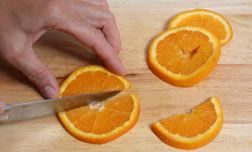 |
| Orange slices can also be cut from an orange that has had the skin, pith and membrane removed, as shown above, to create slices without any peeling. |
|
Slices - Twisted
To use as a garnish, cut the whole orange slice from the center out to the edge, through the skin. Twist each cut end in opposite directions to form an orange twist. |
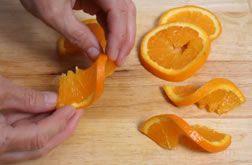 |
|
Slices - Cartwheels
To dress up slices, cut notches lengthwise out of the orange before cutting the slices. Hold the fruit in one hand and pull the zesting tool from one end to the other, cutting a notch in the skin of the orange. Continue to cut lengthwise notches from the rest of the orange at approximately 1/4" inch intervals. |
 |
| After notching the orange, cut slices in same manner as shown above. |
 |
| If a zesting tool is not available, the notches can be cut after the orange is sliced. Use a small knife and cut notches in even intervals around each slice. |
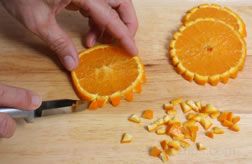 |
|
Wedges
To create easy to eat wedges, cut the orange in half crosswise. Cut each half in half again, cutting perpendicular to the first cut, to create quarter sections. |
 |
| Cut each quarter section in half again, forming 4 wedges per half of orange. |
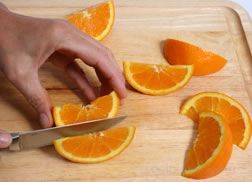 |
|
Orange Peel Slivers
Use the quarter skin sections from peeling an orange, leaving the membrane intact with the flesh as shown above. Remove the pith from the skin by cutting it away with a sharp knife or scraping it off with the tip of a spoon. |
 |
|
Place two sections of skin on top of each other and cut into very thin strips. Repeat this process with the remainder of the skin sections.
The strips can be used as a garnish or in the same manner as zest strips. |
 |
|
Orange Shells
Cut an orange in half crosswise and carefully remove the flesh by cutting it out with a small sharp knife. A grapefruit knife would also work well for cutting around the flesh. |
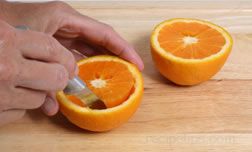 |
| Remove any remaining flesh from the shell by scraping it out with the tip of a spoon. |
 |
| Cut a thin slice off the bottom of each half to allow the shell to sit flat. |
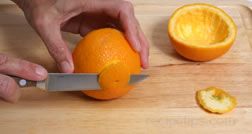 |
| Scallop the edges of the shell by cutting notches along the edge with a kitchen shears or a sharp paring knife. |
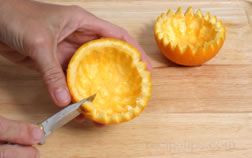 |
|
Shells can be used to serve ice cream, flavored gelatin, yogurt, fresh fruit, dips or other snacks.
If not using the shells immediately they can be place in a plastic sealable bag and store in the refrigerator or frozen for future use. |
 |
Mandarin Preparation
Mandarin oranges can be used in basically the same way as oranges. Mandarins can be used in place of oranges in most recipes. Preparation methods for mandarins are typically the same as the methods used for oranges. The peel is thinner and looser than that of an orange, making it easier to peel. Because of its thin skin, the zest from the mandarin should be removed with the use of a grater. When zesting and juicing, light pressure should be used to grate and extract the juice. Shown below are methods used to peel and remove seeds from the mandarin.
|
Peeling Mandarins
To remove the skin from the mandarin orange, stick your finger between the flesh and peel, and then pull back to remove a section from the fruit. |
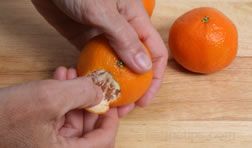 |
| Continue to remove the remaining peel in the same manner until all of it has been removed. |
 |
| Most of the pith should come off with the peel. Scrape off any remaining pith with a knife. |
 |
| The mandarin segments are easily separated by gently pulling them apart. |
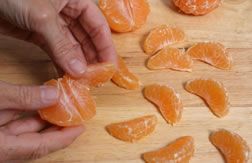 |
|
Removing Seeds
To remove the seeds from the segmented pieces:
- Use a kitchen shears and trim off the membrane just along the inside edge of the segment.
- Gently squeeze to remove the seeds at the opening created by trimming the inside edge.
|
Freezing Oranges
Oranges, orange juice and orange zest can all be frozen for future use. It is a good option for storing oranges when they are in season so they can be used during the off season.
Freezing Orange Juice: Juice the oranges and remove any seeds by pouring through a strainer. Pour the juice in an airtight and leak proof container, leaving 1/2 to 1 inch space on top to allow room for the juice to expand when it freezes. Set upright in the freezer and allow the oranges to freeze. Once the juice is frozen, the container can be stored in any position that provides efficient storage. Orange juice can be stored for up to a year in the freezer.
Freezing Orange Zest: Remove the zest using one of the methods shown above. Place the orange zest in a sealable freezer bag, press out any air that is in the bag and then seal it tightly. Place the bag in the freezer and store for up to a year.
Freezing Oranges: Oranges can be frozen whole, in segments or cut into pieces. Be sure the oranges are sweet with a good flavor and that they are fresh before freezing. If the oranges are getting old, do not freeze. Freeze oranges for up to 6 months. Some simple methods for freezing oranges are shown below.
|
Freezing Whole Oranges
Wash the surface of the oranges to remove any chemicals before freezing. Dry completely before freezing.
Place 3 or 4 oranges in a gallon size freezer bag. |
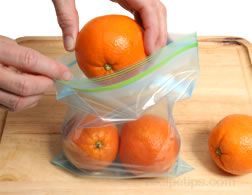 |
| Remove as much air as possible and seal tightly. Place in the freezer and allow the oranges to freeze. |
 |
|
When ready to use, remove the oranges from the freezer and allow to stand at room temperature to thaw. Do not thaw in the microwave.
The frozen oranges hold their shape and color well. |
 |
| The texture of the pulp softens a little and their flavor is affected slightly. When cut open, they have pretty much the same appearance as a fresh orange. |
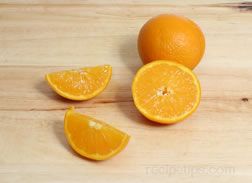 |
| The whole frozen oranges can be cut into slices but be sure to use a sharp knife because the skin is tougher after it is frozen. |
 |
| The whole orange is easy to peel once it is thawed. The pith is removed easily as the orange is peeled. |
 |
|
The peeled orange can then be separated into segments or chopped into pieces.
The oranges may have softened slightly in comparison to when they were fresh but should still be able to be used in the same manner as the fresh fruit. |
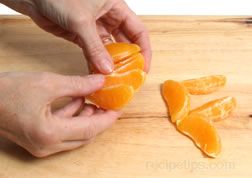 |
| Frozen whole oranges can also be used as a fun and healthy treat. Just cut a whole frozen orange in half while still frozen and use a spoon to scoop out a healthy frozen treat. |
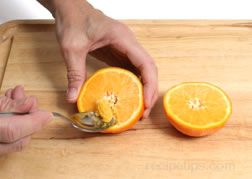 |
|
Freezing Orange Segments

Peel the oranges without boiling first as shown above. After peeling, remove any remaining pith and then pull them apart in segments. |
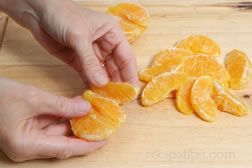 |
| Place the segments in a freezer bag, remove as much air as possible from the bag and then seal tightly. |
 |
| Be sure to mark the freezer bag or container with the contents and the date. Place in the freezer and allow the oranges to freeze. |
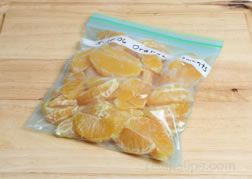 |
| When ready to use, remove from the freezer and allow the oranges to thaw at room temperature. The orange segments can be eaten whole or used in a recipe calling for oranges. They can be used whole or cut into smaller pieces. |
 |
|
Freezing Orange Pieces

Prepare oranges as shown above for cutting segments into bite size pieces. |
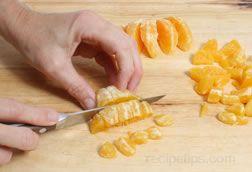 |
|
Place orange pieces into a freezer bag, squeeze out as much air as possible and seal tightly. Be sure to mark the bag with its content and the date. Place in the freezer and allow the orange pieces to freeze. |
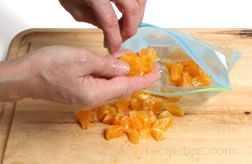 |
| The cut pieces of oranges lose some of their juices during the freezing process. It may be better to freeze the whole segments and then cut into pieces once the segments are thawed. |
 |
Freezing slightly softens the texture of the orange and the flavor may be a little less sharp than a fresh orange but can be used in many recipes. It seems that the flavor is affected the least when the oranges are frozen whole. The more the orange is cut up before freezing the more the flavor is affected. It is best if they can be frozen whole and the segmented or cut into pieces after they are thawed. They can be sliced, segmented or cut into pieces and used as an ingredient in many dishes or left in whole segments and eaten in the same manner as a fresh orange. Using fresh oranges is always best but if oranges are not always available, freezing may be a good option. Orange Recipes
Candied Orange Zest | Orange Sorbet | Orange Chicken Salad
Oranges can be used in many different types of sweet and savory dishes and also in beverages. Recipes may call for the flesh, zest, or juice of the orange or they may call for all three. Most recipes that call for oranges can be prepared using navel oranges, Valencia oranges, blood oranges, or mandarin oranges, such as honey mandarins, tangerines, or tangelos. Shown below are a few recipes where oranges are one of the main ingredients.
Candied Orange Zest
|
Wash oranges thoroughly before beginning preparation.
Trim zest from two navel oranges using a vegetable peeler or a small knife. Cut wide strips, being careful to not cut into the pith layer below. |
 |
|
If zest strips have any pith on them, carefully cut the pith off with a small sharp knife.
Cut strips lengthwise to create thin julienne strips. |
 |
|
Place the orange julienne strips in a small saucepan and cover with cold water.
Cook over medium heat until the water comes to a simmer. Continue to simmer for 6 minutes. |
 |
|
Remove from heat, drain strips and then return them to the saucepan. |
 |
| Add 1/3 cup of water and 1/3 cup of sugar. Bring the mixture to a simmer. |
 |
| Continue to cook over low heat until the orange strips turn translucent. The water and sugar should be starting to thicken. Cooking time will be approximately 10 to 15 minutes. |
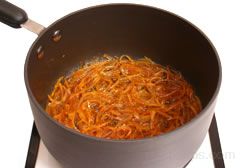 |
|
When done cooking, remove strips from the pan and spread out on a sheet of wax paper. |
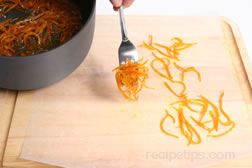 |
| Separate the orange strips on the wax paper and allow them to cool slightly. |
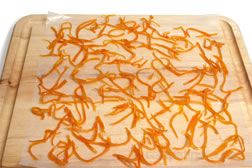 |
| Once they have cooled slightly, roll in sugar until they are well coated. Allow the candied strips to cool completely before storing in an airtight container or bag. Store at room temperature for 2 or 3 days. |
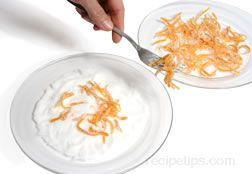 |
Orange Sorbet
Orange Chicken Salad
|
Peel three navel oranges and separate into individual segments as shown above. |
 |
|
Place the segmented orange pieces into a mixing bowl and add the following ingredients:
- 2 1/4 cups cooked chicken cubes
- 3 ribs of celery, diced
Combine the ingredients listed below, stir until well mixed, and then add to the orange slices and other ingredients.
- 1/2 tsp of salt
- 1/8 tsp of pepper
- 1/8 tsp of curry powder
- 1/2 cup fat-free mayonnaise
|
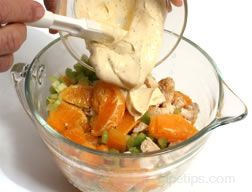 |
| Stir all ingredients gently until evenly mixed together. |
 |
|
Place in the refrigerator to chill and then serve on lettuce leaves. |
 |
Tips
- Prevent browning of fresh cut fruits and vegetables by dipping into a mixture of 1 cup water and 1 tablespoon orange juice or by brushing fruits and vegetables with orange juice.
- One pound of oranges equals approximately 3 medium oranges, 1 cup of juice, 1 to 1 1/2 cups sections, and 4 to 5 tbsp. grated peel. One medium orange equals approximately 1/3 to 1/2 cup juice, 10 to 12 segments, and 1 1/2 to 2 tbsp. grated peel.
- If only using the juice from an orange, first remove the zest and freeze it for future use to add flavor to other dishes. Zest can be frozen for up to 6 months.
- Orange juice stored in an airtight container in the refrigerator will retain up to 90% of its vitamin C for up to 6 or 7 days.
- When squeezing fresh oranges, use some of the pulp in the juice whenever possible to add extra flavor.
- Use blood oranges in place of navel or Valencia oranges to add color and a unique flavor to sweet and savory dishes.
|







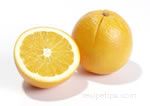















 Fallglo Tangerine
Fallglo Tangerine





